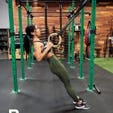When you think about guys with big shoulders—football players, fighters, and weightlifters—it’s easy to imagine that you have to lift heavy weights to look like them. Nothing could be further from the truth. Research shows that as long as you train hard, you can build muscle with virtually any amount of resistance you use. Even the pink, rubber-coated dumbbells your mom stores under the ottoman can be effective.
Don’t believe us? A 2016 study from McMaster University in Ontario gathered 49 college-aged guys who all had several years’ experience lifting weights. Half the subjects trained light, using just 30–50% of their one-rep max on exercises for sets of 20–25 reps. The other half went heavy, using 75–90% of their max for sets in the 8–12 rep range. Both groups trained as hard as they could, taking their sets to failure—the point at which they couldn’t do another rep. Lo and behold, after 12 weeks, the muscle and strength gains between the groups were virtually identical.
If your shoulders already ache from years of heavy training, you no longer have a gym membership that provides access to heavy duty equipment, or you find yourself quarantined with little more than a light pair of dumbbells, or your bodyweight alone, you can still build cannonball-sized delts that make your upper body look broad and your waist tiny. And you can do it in your own home.
How To Stretch Your Shoulders Before A Workout
Onnit Durability Coach Natalie Higby (@nat.trill.fit on Instagram) offers these two mobility drills to increase range of motion and stability in your shoulders and upper back.
The Best Bodyweight Shoulder Workout
This routine requires only your bodyweight, and uses careful exercise sequencing to exhaust the delts front to back. It allows you to train your shoulders with the heaviest, most challenging exercise when they’re well warmed up and activated, reducing the risk for injury while maximizing muscular tension without the need for heavy loading.
The prone snow angel serves as a warmup, activating the full spectrum of delt muscle. From there, the sliding lateral raise offers a much harder but more joint-friendly version of the classic shoulder isolation move, since your shoulder has to lift your whole body on every rep. Next is the modified handstand pushup, which simulates a heavy overhead press. Finally, you’ll finish with the plank with shoulder tap—a hard balancing act that will once again ask your delts to support your body weight, and your core to prevent you from falling.
Directions
Perform the exercises as straight sets, completing all sets for one move before going on to the next. Except where otherwise noted, always leave two reps in your tank on every set, for the sake of safety. In other words, if you feel you have 15 reps in you, perform only 13. Seek to improve your performance by one rep each time you repeat the workout.
1 Prone Snow Angel
Sets: 3 Reps: 10–15 Rest: 45 sec.
Step 1. Lie on your chest on the floor and brace your core. Extend your spine to raise your chest off the floor slightly, and raise your hands overhead.
Step 2. Extend your arms out to your sides and draw them down, rotating your palms to face the ceiling. Continue until the back of your hands touches the small of your back.
Step 3. Rotate your hands back and reach your arms overhead again. It should look like you’re making a snow angel upside down. That’s one rep.
2 Sliding Lateral Raise on Wall
Sets: 3 Reps: Work for 40 sec. Rest: 45 sec.
Step 1. Stand next to a wall or other sturdy surface that can support your body weight. Bend your elbow 90 degrees, and draw your shoulders back and downward. Brace your core.
Step 2. Lean against the wall with the outside of your forearm. Raise your arm, sliding it up the wall so it moves your torso more upright. Control the movement so it’s smooth. When your upper arm is 90 degrees to your torso, reverse the motion. Continue performing reps for 40 seconds, and then switch arms and repeat.
3 Modified Handstand Pushup
Sets: 3 Reps: 8–10 Rest: 90 sec.
Step 1. Rest your feet on a bench, chair, or other stable surface, and place your hands on the floor, shoulder-width apart. Walk your hands back while bending your hips and driving your butt up into the air so that your torso is as vertical as possible.
Step 2. Lower your body until the top of your head touches the floor, and then press back up.
If that’s too hard, simply perform a pushup on a very steep incline. If it’s not challenging enough to stay in the 8–10 rep range, try a handstand pushup against the wall.
4 Plank W/ Shoulder Tap
Sets: 2 Reps: As many as possible Rest: 45 sec.
Step 1. Get into pushup position with your hands at shoulder width. Brace your core.
Step 2. Hold the position as you tap one shoulder at a time with the opposite hand. Avoid any twisting at the shoulders or hips.
The Best Shoulder Workout for Light Dumbbells
High reps and short rest periods can always substitute for heavy weights. This workout is so fast-paced and burn-focused that a strong man could literally do it with his mom’s dumbbells, or maybe even a pair of water bottles. Another cool feature: you don’t even have to stand up to do it. Sit on the edge of a bench and move from one exercise to another. You’ll start with dumbbell raise variations to pre-exhaust the delts, and then finish with an overhead press to burn them out. Doing the press first wouldn’t be very challenging with light weights, but placed so far back in the workout when you’re already fatigued, whatever weights you have access to will be more than heavy enough.
Directions
Perform the exercises as a circuit, completing one set for each in sequence without rest in between. So you’ll do one set of the Y raise, then immediately go on to the lateral raise, rear-delt swing, and so on. Afterward, rest two minutes, and then repeat the circuit once more.
1 Y Raise
Reps: 10–15
Step 1. Sit on a bench with a light dumbbell in each hand. Bend at the hips so that your torso is 45 degrees, but keep your head, spine, and pelvis aligned.
Step 2. Raise your arms in front of you and slightly out to the sides, as if making a Y shape.
2 Seated Lateral Raise
Reps: As many as possible
Step 1. Sit up straight with your arms at your sides. (You may keep a slight forward lean if that feels better for your shoulders.)
Step 2. Raise your arms out 90 degrees with your palms facing down.
3 Rear-Delt Swing
Reps: As many reps as possible
Step 1. Bend forward at the hips again, as far as you can while keeping a long spine and your lower back flat.
Step 2. Use momentum to raise your arms up to 90 degrees, so you’re performing a swinging motion. Control the descent, and use momentum to begin the next rep.
4 Rear-Delt Row
Reps: As many as possible
Step 1. Staying bent forward, turn your palms to face down.
Step 2. Row the weights with your elbows pointing outward until your upper back is fully contracted.
5 Arcing Overhead Press
Reps: As many reps as possible
Step 1. Sit upright and brace your core. Raise the weights to shoulder level with your palms facing forward.
Step 2. Press the weights overhead in an arcing motion, stopping short of locking out the elbows.

)





